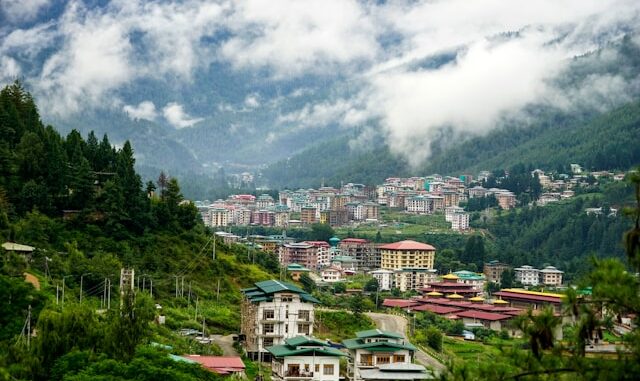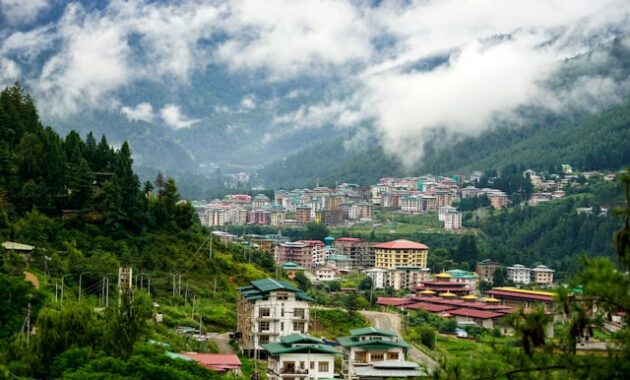
Bhutan, the mystical kingdom nestled in the Himalayas, offers not only breathtaking landscapes and a rich spiritual heritage but also a distinct and flavorful cuisine that reflects its cultural depth. Bhutanese food is earthy, spicy, and deeply rooted in tradition, making it a culinary journey unlike any other. Here’s our comprehensive guide to what to eat in Bhutan, filled with local foods that will surprise you and leave a lasting impression.

Ema Datshi: The Fiery National Dish
Ema Datshi is the crown jewel of Bhutanese cuisine. This dish consists of chilies (ema) cooked in a cheese (datshi)sauce made from yak or cow’s milk. It’s not just a meal—it’s a cultural emblem. Expect a fiery kick, as Bhutanese people relish spice, often incorporating multiple types of green and red chilies.
There are several variations:
- Kewa Datshi: Potatoes with cheese and chilies.
- Shamu Datshi: Mushrooms in cheese sauce.
- Sikam Datshi: Dried pork with chilies and cheese.
Ema Datshi is served daily across Bhutan, from royal feasts to rural homes, and it is a must-try dish for every visitor.
Phaksha Paa: Pork with Radishes and Red Chilies
A dish that brings together succulent pork slices, dried red chilies, and daikon radish, Phaksha Paa is a popular non-vegetarian favorite. It’s often cooked with dried pork (sikam), which gives it a smoky richness that balances the spiciness of the chilies.
Typically served with red rice, this dish showcases the Bhutanese mastery of flavor layering, combining savory, spicy, and earthy tones in a single bite.
Jasha Maru: Spicy Chicken Stew with a Kick
Jasha Maru is a spicy chicken curry made with boneless chicken, garlic, ginger, onions, tomatoes, and, of course, chilies. The stew is light but flavorful, offering a delicate balance of warmth and aroma. It’s one of the more palatable options for travelers who may find other dishes too fiery.
Often served over red rice, it’s a common dish in Bhutanese households and a satisfying meal after a long trek or monastery visit.
Red Rice: The Staple of Bhutanese Dining
Bhutanese red rice is more than a side dish—it is a culinary cornerstone. Grown in the fertile valleys of Paro, this rice has a nutty flavor and a slightly chewy texture. It’s semi-milled, which means it retains more nutrients than white rice, and is perfect for soaking up the rich gravies of Bhutanese stews and curries.
Due to its high altitude cultivation, red rice is unique to Bhutan and forms the basis of nearly every traditional meal.
Sikam Paa: Dried Pork Belly Delight
Sikam Paa is a delicacy made from sun-dried pork belly, heavily salted and then fried with chilies. This dish is rich, fatty, and addictive, especially for those who love bold, meaty flavors.
What makes Sikam Paa stand out is its intense umami and satisfying crispiness. It’s often prepared during winter and served in small portions due to its richness. A local favorite, it pairs excellently with buttered tea or red rice.
Hoentay: The Bhutanese Dumpling Surprise
Originating from the Haa Valley, Hoentay are buckwheat dumplings filled with spinach, cheese, and turnip greens. They’re similar to Tibetan momos but use buckwheat flour instead of wheat, giving them a more robust texture and a nutty taste.
These dumplings are steamed or fried and are traditionally eaten during Lomba, the local New Year festival. Hoentay is a comfort food, offering a rich cultural taste of Bhutanese tradition.
Suja: The Salty Butter Tea
Unlike the sweet chai of India or green tea of China, Suja is a salty butter tea made from yak butter and tea leaves, churned until it becomes a frothy, creamy beverage. Served hot, it’s an essential part of Bhutanese hospitality, especially in highland regions.
Suja is best enjoyed during cold mornings or with snacks like zow shungo (rice with leftover vegetables). It may surprise your taste buds initially, but it’s a soothing drink perfect for Bhutan’s alpine climate.
Zow Shungo: A Sustainable Delicacy
Zow Shungo is a dish made from leftover vegetables and rice, embodying the Bhutanese philosophy of zero food waste. It’s a simple yet delicious stir-fry that varies depending on the day’s leftovers.
Seasoned with garlic and a touch of chili, it’s a humble yet heartwarming meal, often eaten for breakfast or lunch. It reflects the practical, mindful cooking style that characterizes Bhutanese kitchens.
Goen Hogay: Bhutanese Cucumber Salad
For something light and refreshing, Goen Hogay is a must. This spicy cucumber salad includes sliced cucumbers, chilies, coriander, onions, and cheese, all mixed with a splash of mustard oil.
Served cold, it’s a perfect contrast to Bhutan’s many hot dishes. Goen Hogay is both crunchy and zesty, making it an excellent side dish during summer.
Khuli and Puta: Buckwheat-Based Alternatives
In central Bhutan, especially in the Bumthang region, buckwheat is widely used in place of rice.
- Khuli: Soft buckwheat pancakes, often eaten with curries or eggs.
- Puta: Buckwheat noodles served either cold or hot, tossed with sautéed vegetables and spices.
These dishes offer nutritional benefits and are perfect for gluten-free diets. Their earthy flavors make them distinctively Bhutanese.
Ara: The Traditional Alcoholic Beverage
Ara is a homemade spirit distilled from rice, wheat, or maize. It can be served warm or cold, sometimes infused with butter and eggs for special occasions. Ara is often enjoyed during religious rituals, festivals, or simply as a celebratory drink.
Though not widely available in restaurants, locals may offer it during homestays or cultural events, providing a unique glimpse into Bhutanese hospitality and tradition.
Final Thoughts: A Feast for the Adventurous
Exploring Bhutanese cuisine is not just about tasting new dishes—it’s about experiencing the cultural soul of a nation that values simplicity, sustainability, and community. From the fierce heat of Ema Datshi to the comfort of Suja, every bite tells a story of tradition and terrain.
Whether you’re trekking through the Himalayas or wandering through Thimphu’s markets, don’t miss the chance to indulge in the bold and unique flavors that define Bhutanese food.